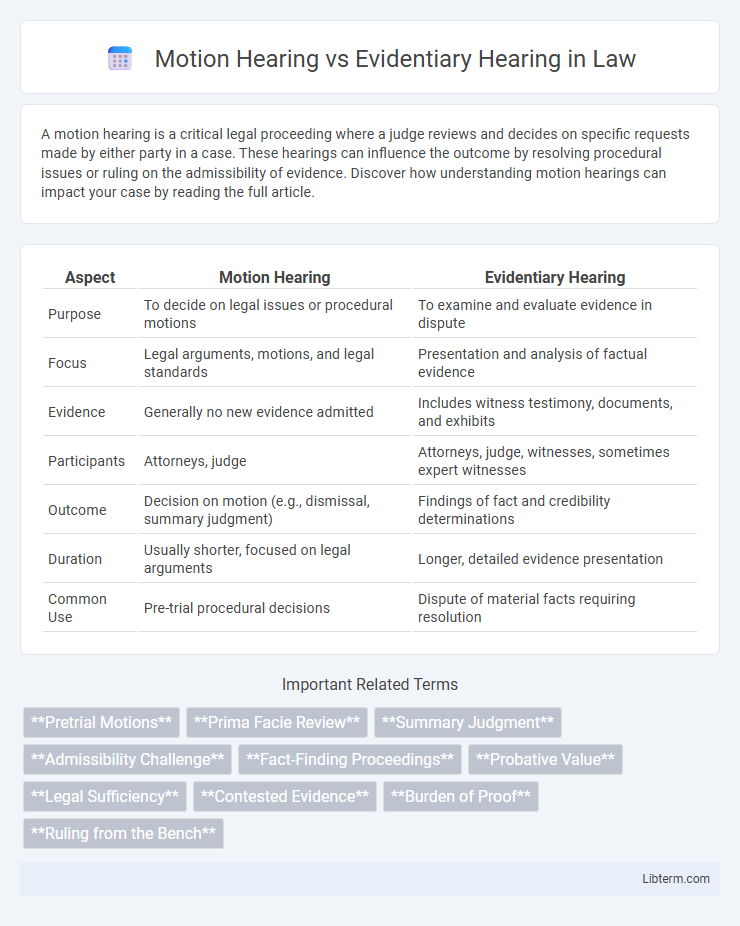A motion hearing is a critical legal proceeding where a judge reviews and decides on specific requests made by either party in a case. These hearings can influence the outcome by resolving procedural issues or ruling on the admissibility of evidence. Discover how understanding motion hearings can impact your case by reading the full article.
Table of Comparison
| Aspect | Motion Hearing | Evidentiary Hearing |
|---|---|---|
| Purpose | To decide on legal issues or procedural motions | To examine and evaluate evidence in dispute |
| Focus | Legal arguments, motions, and legal standards | Presentation and analysis of factual evidence |
| Evidence | Generally no new evidence admitted | Includes witness testimony, documents, and exhibits |
| Participants | Attorneys, judge | Attorneys, judge, witnesses, sometimes expert witnesses |
| Outcome | Decision on motion (e.g., dismissal, summary judgment) | Findings of fact and credibility determinations |
| Duration | Usually shorter, focused on legal arguments | Longer, detailed evidence presentation |
| Common Use | Pre-trial procedural decisions | Dispute of material facts requiring resolution |
Understanding Motion Hearings: Definition and Purpose
Motion hearings are legal proceedings where parties request the court to make a ruling on specific matters before the trial, such as motions to dismiss or motions for summary judgment, aimed at resolving issues without a full trial. They help streamline the litigation process by addressing procedural or substantive questions early, saving time and resources. Understanding the definition and purpose of motion hearings is essential for effective case management and strategic decision-making in legal practice.
What is an Evidentiary Hearing? Key Features
An evidentiary hearing is a judicial proceeding where parties present evidence and testimony to resolve factual disputes in a case. Key features include live witness testimonies, the admission of physical and documentary evidence, and examiner cross-examinations to establish factual clarity. Unlike a motion hearing, which focuses on legal arguments and preliminary issues, evidentiary hearings are essential for determining the truth of contested facts directly impacting the case outcome.
Core Differences: Motion Hearing vs Evidentiary Hearing
A motion hearing primarily addresses legal issues, such as requests to dismiss a case or compel evidence, without the need for witness testimony or evidence presentation. An evidentiary hearing centers on resolving factual disputes by evaluating witness testimonies, physical evidence, and expert opinions. The core difference lies in the nature of the hearing: motion hearings focus on legal arguments, while evidentiary hearings examine contested facts to guide judicial decisions.
Types of Issues Addressed in Motion Hearings
Motion hearings primarily address preliminary legal issues such as requests to dismiss a case, exclude evidence, or compel discovery, focusing on procedural disputes rather than factual determinations. These hearings evaluate the legal sufficiency of claims or defenses and the admissibility of evidence before trial. Unlike evidentiary hearings, which involve assessing witness credibility and actual evidence to resolve disputed facts, motion hearings streamline case management by resolving legal questions early.
Types of Evidence Presented in Evidentiary Hearings
Evidentiary hearings involve the presentation of various types of evidence, including witness testimony, expert reports, physical exhibits, and documentary proof, which are crucial for establishing the facts of the case. Unlike motion hearings that primarily rely on legal arguments and limited evidence such as affidavits or declarations, evidentiary hearings allow for cross-examination and detailed examination of evidence. This comprehensive presentation ensures that the judge or jury can make informed decisions based on the full factual record.
Legal Procedures in Motion Hearings
Motion hearings are judicial procedures where parties request the court to make a ruling on specific legal issues before trial, relying primarily on submitted documents and oral arguments rather than full evidentiary presentations. These hearings focus on interpreting the law and applying it to the undisputed facts, streamlined to resolve preliminary questions efficiently. Unlike evidentiary hearings, motion hearings typically exclude witness testimony and live evidence, emphasizing procedural rules and legal standards to determine whether cases proceed or are dismissed.
Legal Procedures in Evidentiary Hearings
Evidentiary hearings involve presenting and examining evidence, witness testimonies, and expert opinions under strict procedural rules to establish factual issues. These hearings require adherence to rules of evidence, such as relevance, admissibility, and hearsay exclusions, ensuring a fair and thorough evaluation by the court. Unlike motion hearings that primarily focus on legal arguments and procedural questions, evidentiary hearings are essential for resolving disputed facts critical to case outcomes.
When is a Motion Hearing Necessary?
A motion hearing is necessary when a party in a legal case requests the court to make a ruling on specific procedural or substantive issues before a trial begins, such as motions to dismiss or for summary judgment. This hearing allows the judge to evaluate arguments and evidence exclusively related to the motion, guiding case management without addressing the underlying facts of the dispute. Motion hearings differ from evidentiary hearings, which focus on evaluating evidence directly related to factual determinations crucial to the case's outcome.
When is an Evidentiary Hearing Required?
An evidentiary hearing is required when a judge needs to resolve disputed facts based on evidence presented by both parties, such as witness testimony or documents, beyond what is available in written motions. These hearings are essential in complex cases where factual clarification is necessary before a final ruling. Unlike motion hearings, which typically rely on legal arguments and existing records, evidentiary hearings establish the factual foundation for judicial decisions.
Impact on Case Outcomes: Motion Hearing vs Evidentiary Hearing
Motion hearings typically determine whether specific legal arguments or procedural issues will influence the direction of a case, often impacting pretrial rulings and case posture. Evidentiary hearings focus on the admissibility and credibility of evidence, directly affecting the strength and validity of the evidence considered at trial. The outcome of motion hearings can streamline or complicate litigation strategy, while evidentiary hearings shape the factual foundation critical to a case's verdict.
Motion Hearing Infographic

 libterm.com
libterm.com